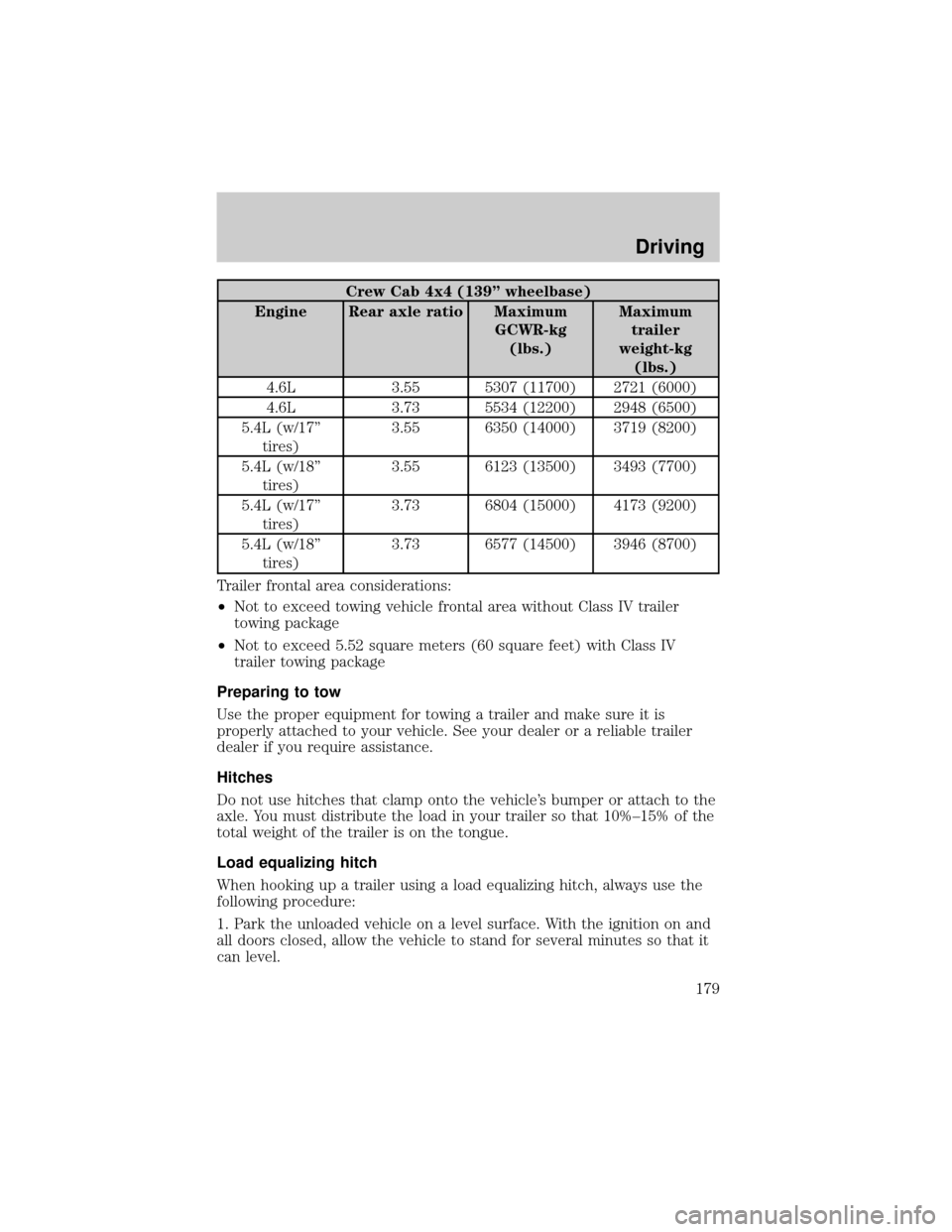Page 175 of 280
Regular Cab 4x4 (126º wheelbase)
Engine Rear axle ratio Maximum
GCWR-kg
(lbs.)Maximum
trailer
weight-kg
(lbs.)
5.4L (w/17º
tires)3.55 5897 (13000) 3447 (7600)
5.4L (w/18º
tires)3.55 5670 (12500) 3220 (7100)
5.4L (w/17º
tires)3.73 6123 (13500) 3674 (8100)
5.4L (w/18º
tires)3.73 5897 (13000) 3447 (7600)
Regular Cab 4x4 (145º wheelbase)
Engine Rear axle ratio Maximum
GCWR-kg
(lbs.)Maximum
trailer
weight-kg
(lbs.)
4.6L 3.55 5307 (11700) 2812 (6200)
4.6L 3.73 5534 (12200) 3039 (6700)
5.4L (w/17º
tires)3.55 6350 (14000) 3856 (8500)
5.4L (w/18º
tires)3.55 6123 (13500) 3629 (8000)
5.4L (w/17º
tires)3.73 6804 (15000) 4309 (9500)*
5.4L (w/18º
tires)3.73 6577 (14500) 4082 (9000)
5.4L Heavy Duty 4.10 6940 (15300) 4309 (9500)*
* Trailer tow capability is limited to 4309 kg (9500 lbs.)
Driving
175
Page 176 of 280
SuperCab 4x2 (133º wheelbase)
Engine Rear axle ratio Maximum
GCWR-kg
(lbs.)Maximum
trailer
weight-kg
(lbs.)
4.6L 3.55 5216 (11500) 2858 (6300)
4.6L 3.73 5443 (12000) 3084 (6800)
5.4L (w/17º
tires)3.55 5897 (13000) 3447 (7600)
5.4L (w/18º
tires)3.55 5670 (12500) 3220 (7100)
5.4L (w/17º
tires)3.73 6123 (13500) 3674 (8100)
5.4L (w/18º
tires)3.73 5897 (13000) 3447 (7600)
SuperCab 4x2 (145º wheelbase)
Engine Rear axle ratio Maximum
GCWR-kg
(lbs.)Maximum
trailer
weight-kg
(lbs.)
4.6L 3.55 5307 (11700) 2858 (6300)
4.6L 3.73 5534 (12200) 3084 (6800)
5.4L (w/17º
tires)3.55 6350 (14000) 3856 (8500)
5.4L (w/18º
tires)3.55 6123 (13500) 3629 (8000)
5.4L (w/17º
tires)3.73 6804 (15000) 4309 (9500)*
5.4L (w/18º
tires)3.73 6577 (14500) 4082 (9000)
* Trailer tow capability is limited to 4309 kg (9500 lbs.)
Driving
176
Page 177 of 280
SuperCab 4x2 (163º wheelbase)
Engine Rear axle ratio Maximum
GCWR-kg
(lbs.)Maximum
trailer
weight-kg
(lbs.)
5.4L Heavy Duty 4.10 6940 (15300) 4309 (9500)*
* Trailer tow capability is limited to 4309 kg (9500 lbs.)
SuperCab 4x4 (133º wheelbase)
Engine Rear axle ratio Maximum
GCWR-kg
(lbs.)Maximum
trailer
weight-kg
(lbs.)
4.6L 3.55 5216 (11500) 2676 (5900)
4.6L 3.73 5443 (12000) 2903 (6400)
5.4L (w/17º
tires)3.55 5897 (13000) 3311 (7300)
5.4L (w/18º
tires)3.55 5670 (12500) 3084 (6800)
5.4L (w/17º
tires)3.73 6123 (13500) 3538 (7800)
5.4L (w/18º
tires)3.73 5897 (13000) 3311 (7300)
SuperCab 4x4 (145º wheelbase)
Engine Rear axle ratio Maximum
GCWR-kg
(lbs.)Maximum
trailer
weight-kg
(lbs.)
4.6L 3.55 5307 (11700) 2721 (6000)
4.6L 3.73 5534 (12200) 2948 (6500)
5.4L (w/17º
tires)3.55 6350 (14000) 3765 (8300)
5.4L (w/18º
tires)3.55 6123 (13500) 3538 (7800)
Driving
177
Page 178 of 280
SuperCab 4x4 (145º wheelbase)
Engine Rear axle ratio Maximum
GCWR-kg
(lbs.)Maximum
trailer
weight-kg
(lbs.)
5.4L (w/17º
tires)3.73 6804 (15000) 4218 (9300)
5.4L (w/18º
tires)3.73 6577 (14500) 3992 (8800)
SuperCab 4x4 (163º wheelbase)
Engine Rear axle ratio Maximum
GCWR-kg
(lbs.)Maximum
trailer
weight-kg
(lbs.)
5.4L Heavy Duty 4.10 6940 (15300) 4173 (9200)
Crew Cab 4x2 (139º wheelbase)
Engine Rear axle ratio Maximum
GCWR-kg
(lbs.)Maximum
trailer
weight-kg
(lbs.)
4.6L 3.55 5307 (11700) 2812 (6200)
4.6L 3.73 5534 (12200) 3039 (6700)
5.4L (w/17º
tires)3.55 6350 (14000) 3856 (8500)
5.4L (w/18º
tires)3.55 6123 (13500) 3629 (8000)
5.4L (w/17º
tires)3.73 6804 (15000) 4309 (9500)*
5.4L (w/18º
tires)3.73 6577 (14500) 4082 (9000)
* Trailer tow capability is limited to 4309 kg (9500 lbs.)
Driving
178
Page 179 of 280

Crew Cab 4x4 (139º wheelbase)
Engine Rear axle ratio Maximum
GCWR-kg
(lbs.)Maximum
trailer
weight-kg
(lbs.)
4.6L 3.55 5307 (11700) 2721 (6000)
4.6L 3.73 5534 (12200) 2948 (6500)
5.4L (w/17º
tires)3.55 6350 (14000) 3719 (8200)
5.4L (w/18º
tires)3.55 6123 (13500) 3493 (7700)
5.4L (w/17º
tires)3.73 6804 (15000) 4173 (9200)
5.4L (w/18º
tires)3.73 6577 (14500) 3946 (8700)
Trailer frontal area considerations:
²Not to exceed towing vehicle frontal area without Class IV trailer
towing package
²Not to exceed 5.52 square meters (60 square feet) with Class IV
trailer towing package
Preparing to tow
Use the proper equipment for towing a trailer and make sure it is
properly attached to your vehicle. See your dealer or a reliable trailer
dealer if you require assistance.
Hitches
Do not use hitches that clamp onto the vehicle's bumper or attach to the
axle. You must distribute the load in your trailer so that 10%±15% of the
total weight of the trailer is on the tongue.
Load equalizing hitch
When hooking up a trailer using a load equalizing hitch, always use the
following procedure:
1. Park the unloaded vehicle on a level surface. With the ignition on and
all doors closed, allow the vehicle to stand for several minutes so that it
can level.
Driving
179
Page 181 of 280

If it is necessary to relocate the trailer hitch ball position, a
frame-mounted trailer hitch must be installed.
Driving while you tow
When towing a trailer:
²Turn off the speed control. The speed control may shut off
automatically when you are towing on long, steep grades.
²Consult your local motor vehicle speed regulations for towing a trailer.
²To eliminate excessive shifting, use a lower gear. This will also assist
in transmission cooling. (For additional information, refer to the
Understanding the positions of the 4±speed automatic
transmissionsection in this chapter.
²Anticipate stops and brake gradually.
²Do not exceed the GCWR rating or transmission damage may occur.
Servicing after towing
If you tow a trailer for long distances, your vehicle will require more
frequent service intervals. Refer to your scheduled maintenance guide for
more information.
Trailer towing tips
²Practice turning, stopping and backing up before starting on a trip to
get the feel of the vehicle trailer combination. When turning, make
wider turns so the trailer wheels will clear curbs and other obstacles.
²Allow more distance for stopping with a trailer attached.
²The trailer tongue weight should be 10±15% of the loaded trailer
weight.
²After you have traveled 80 km (50 miles), thoroughly check your
hitch, electrical connections and trailer wheel lug nuts.
²To aid in engine/transmission cooling and A/C efficiency during hot
weather while stopped in traffic, place the gearshift lever in P (Park)
(automatic transmission) or N (Neutral) (manual transmissions).
²Vehicles with trailers should not be parked on a grade. If you must
park on a grade, place wheel chocks under the trailer's wheels.
Launching or retrieving a boat
Disconnect the wiring to the trailer before backing the trailer
into the water. Reconnect the wiring to the trailer after the
trailer is removed from the water.
Driving
181
Page 182 of 280

When backing down a ramp during boat launching or retrieval:
²do not allow the static water level to rise above the bottom edge of
the rear bumper.
²do not allow waves to break higher than 15 cm (6 inches) above the
bottom edge of the rear bumper.
Exceeding these limits may allow water to enter vehicle components:
²causing internal damage to the components.
²affecting driveability, emissions and reliability.
Replace the rear axle lubricant any time the axle has been submerged in
water. Rear axle lubricant quantities are not to be checked or changed
unless a leak is suspected or repair required.
RECREATIONAL TOWING (ALL WHEELS ON THE GROUND)
An example of recreational towing would be towing your vehicle behind
a motorhome. Follow these guidelines if you have the need for
recreational towing your vehicle with all four wheels on the ground.
These guidelines are designed to ensure that your transmission is not
damaged.
2WD vehicles:
²Place the transmission in N (Neutral)
²Maximum speed is 56 km (35 mph)
²Maximum distance is 80 km (50 miles)
If a distance of 80 km (50 miles) or a speed of 56 km (35 mph) must be
exceeded, the drive shaft will have to be removed before the vehicle is
towed.
Ford recommends the driveshaft be removed/installed only by a qualified
technician. See your local dealer for driveshaft removal/installation.
Improper removal/installation of the driveshaft can cause
transmission fluid loss, damage to the driveshaft and internal
transmission components.
4WD vehicles electronic shift transfer case:
4x4 vehicles with electronic shift on the fly cannot be towed with any
wheels on the ground.
SNOWPLOWING
Ford recommends that the F±150 used for snow removal include the
Snow Plow Prep Package Option. The option is available for F±150 4x4
Driving
182
Page 183 of 280

Regular Cab and Super Cab (not available or recommended for
SuperCrew), and includes the following upgrades:
²F±150 4x4 (except F±150 SuperCrew)
²5.4L engine
²Heavy-duty payload package
²Snowplow prep package
Installing the snowplow
Weight limits and guidelines for selecting and installing the snowplow can
be found in the Ford Truck Body Builders Layout Book, Snowplow
section, found at www.fleet.ford.com/truckbbas. A typical installation
affects the following:
²Certification to government safety laws such as occupant protection
and air bag deployment, braking, and lighting. Look for an9Alterer's
Label9on the vehicle from the snowplow installer certifying that the
installation meets all applicable Federal Motor Vehicle Safety
Standards (FMVSS).
²The Total Accessory Reserve Capacity (TARC) is shown on the lower
right side of the vehicle's Safety Certification Label. This is the weight
of permanently-attached auxiliary equipment, such as snowplow
frame-mounting hardware, that can be added to the vehicle and satisfy
Ford compliance certification to FMVSS. Exceeding this weight may
require the auxiliary equipment installer additional safety certification
responsibility. The Front Accessory Reserve Capacity (FARC) is added
for customer convenience
²Rear ballast weight behind the rear axle may be required to prevent
exceeding the FGAWR, and provide front-to-rear weight balance for
proper braking and steering.
²Front wheel toe may require re-adjustment to prevent premature
uneven tire wear. Specifications are found in the Ford Workshop
Manual.
²Headlight aim may require re-adjustment.
²The tire air pressures recommended for general driving are found on
the vehicle's Safety Certification Label. The maximum cold inflation
pressure for the tire and associated load rating is imprinted on the tire
sidewall. Tire air pressure may require re-adjustment within these
pressure limits to accommodate the additional weight of the snowplow
installation
Driving
183